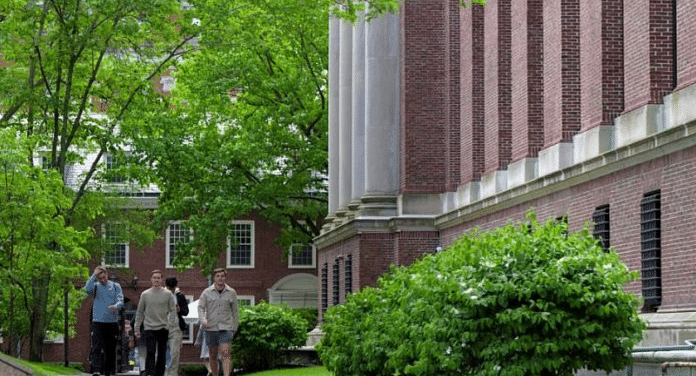Law school is back in fashion.
Applicants to US law schools numbered 76,496 for the 2024-2025 admission cycle, up 18% from 2023-2024 — the biggest percentage gain on record (going back to 1989).(1) The number of applicants for next year is up 29% through Oct. 28. “Early volumes can be highly volatile, and thus are not always reflective of application cycle trends,” cautions the source of these statistics, the Law School Admission Council, but it does seem safe to say that the trend continues to be upward.
Why this return to popularity? In test-prep firm Kaplan’s most recent survey of law school admissions officers, 94% said the current political climate in the US played at least a moderate role in the increase. A Kaplan survey obtained a similar result during President Donald Trump’s first term in 2019 — when the phenomenon became known as the “Trump bump” — but the increase in applicants at the time was much smaller. That leads me to believe that other factors may weigh heavier now, perhaps economic ones.
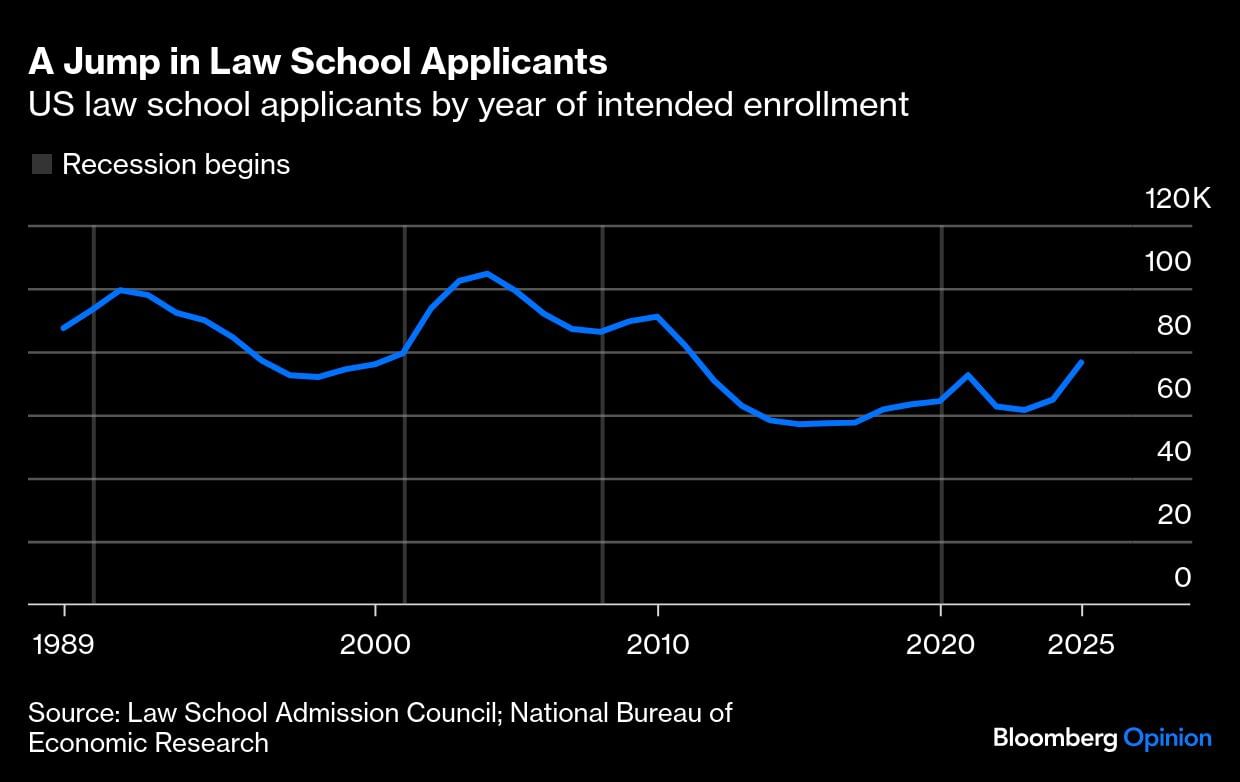
All the other large increases in law-school applications since 1989 have come during or just after recessions. The US economy does not appear to be in a recession now — the latest estimate from the Federal Reserve Bank of Atlanta’s GDPNow puts annualized gross domestic product growth at 3.9% in the third quarter — but there’s certainly lots of talk about economic risks ahead as well as a job market that has turned uniquely unfavorable for recent college graduates.
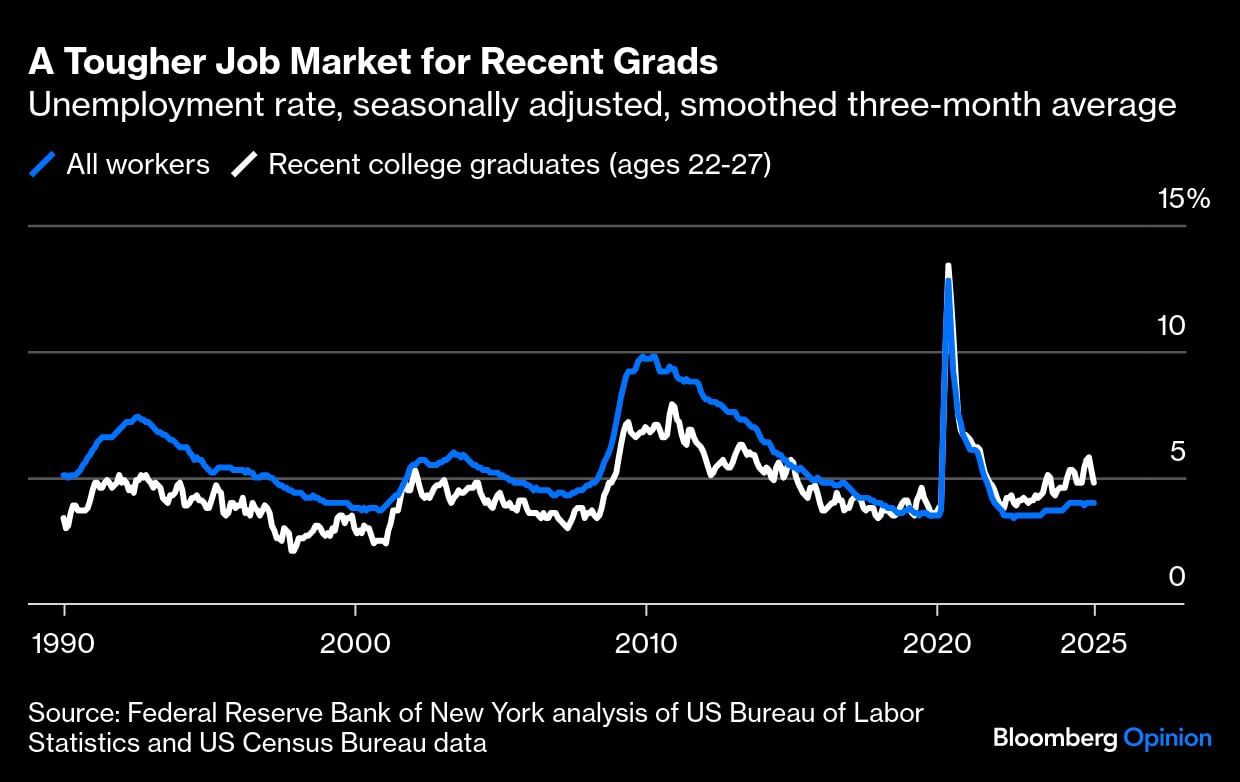
Law school has long served as a fallback for college graduates with reasonably good grades who can’t find good jobs or just can’t decide what they want to do when they grow up. With generative artificial intelligence possibly behind the hiring slowdown for young grads and definitely driving uncertainty about the future of white-collar work, there are surely more recent graduates in this position now than a few years ago. With the Trump administration on the warpath against federal civil servants and an unsettling recent barrage of corporate layoff announcements, it’s not just recent college graduates, either. The rise in law school applications may well be a warning sign of economic distress.
Still, there are other interpretations. Law school attracts smart people looking for high-paying, prestigious work, and after a long slump, lawyer pay has risen in recent years. The starting annual salary at top law firms was stuck at $160,000 from 2007 to 2015, according to Biglaw Investor, a financial advice site for lawyers, but has risen to $225,000 since, outpacing inflation. In the late 1960s, there was a spectacular increase in starting pay at New York law firms, with Cravath, Swaine & Moore going from $9,500 in 1967 to $15,000 in 1968; others soon did the same. This was followed by a 53% increase in first-year law school enrollment over the next three years, then a slowdown, inspiring Harvard University labor economist Richard B. Freeman in 1975 to propose a “recursive model” of law school enrollment that “generates endogenous cyclical fluctuations, with small (large) graduating classes increasing (reducing) salaries, altering incentives and numbers of new enrollees, which in turn alters future graduates and salaries.” More recent research has offered support for this account.
This doesn’t really seem to explain the longer-run trajectory of law school enrollment, which, according to the American Bar Association, followed that 53% jump from 1968 to 1971 with a long, slower rise to a peak in 2010 and then a collapse. Before even finishing high school in the early 1980s, I had read a book (Scott Turow’s One L), watched a movie (The Paper Chase) and caught a few episodes of a TV show (also The Paper Chase) depicting the first year of Harvard Law School (the fact that I had two siblings applying to law school at the time probably had something to do with this), so I have the impression that law school used to have more cultural salience than it does now. Which led to this chart (let me know if I’m missing anything):
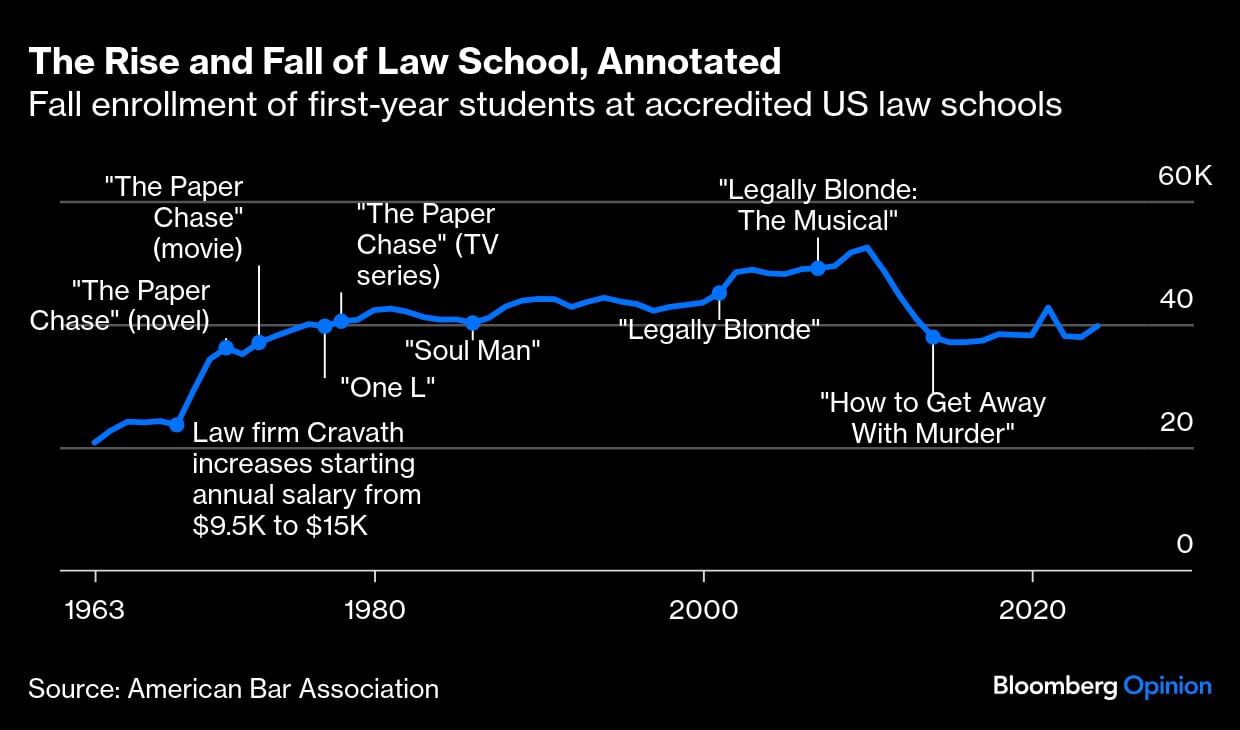
I hemmed and hawed about whether to include the 2014-2020 TV series How to Get Away With Murder, which is set at a fictionalized version of the University of Pennsylvania Law School but is mostly about the murder(s) of the title. The Harvard-set Legally Blonde was certainly about law school but didn’t have quite the same pretensions to realism that One L and the The Paper Chase did. The same appears to go for Soul Man, the 1986 comedy/romance about C. Thomas Howell pretending to be Black to get a scholarship to Harvard Law, learning important lessons about racism in America and falling in love with Rae Dawn Chong (I’m relying on Wikipedia because I haven’t seen it).
So yes, pop culture was especially heavy on law school in the 1970s and has been especially light on it since Legally Blonde. One obvious explanation is that from the 1960s onward, American pop culture was heavy on whatever the baby boomers were interested in, and in the 1970s a lot of boomers were interested in what to do after college. The similarly culture-dominating millennials, aka echo boomers, were beginning to hit law school age when Legally Blonde came out in 2001. The boomers and millennials were much more numerous than the generations just before and after them, so simple demographics explain some of law school’s rise and fall. Still, when I divided the law school first-year enrollment numbers by the numbers of new college graduates, I was surprised to see how negative the long-run trend was.
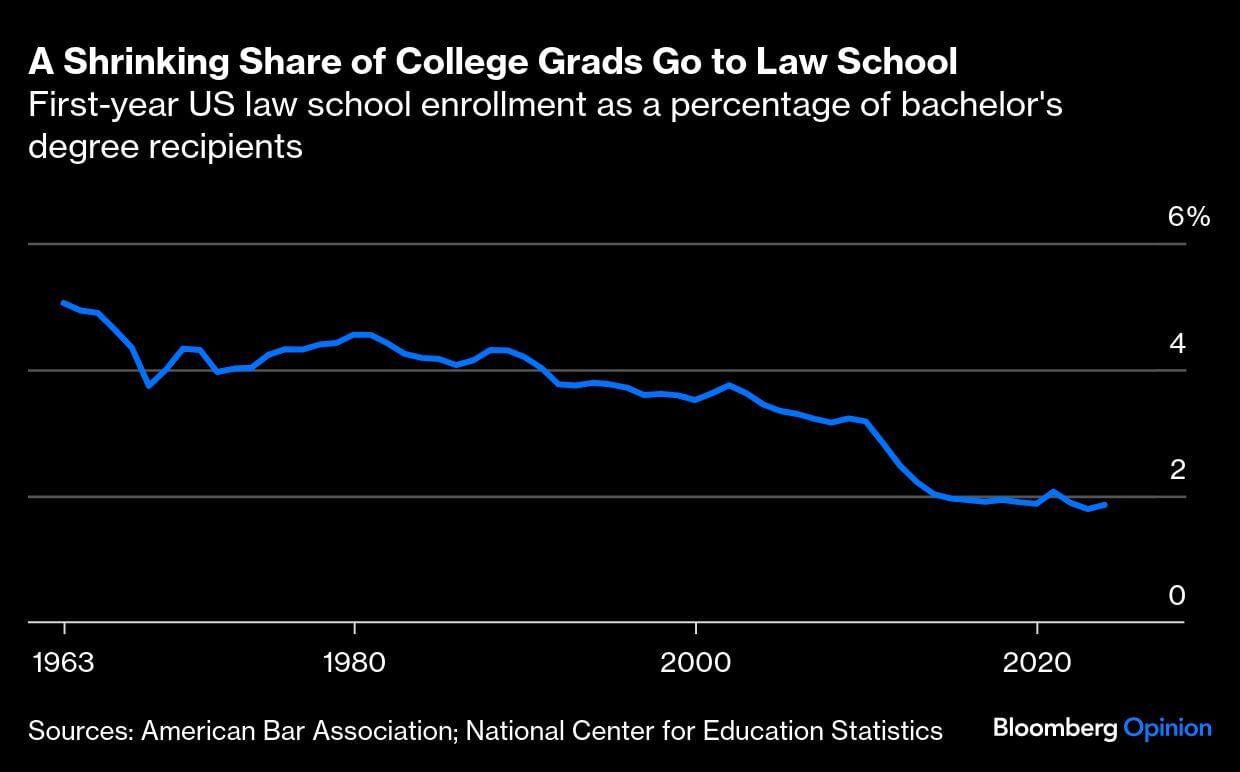
The percentage of Americans who graduate from college has, of course, risen a lot, and lawyers’ share of the overall US workforce has actually grown over the past quarter century — from 0.36% in 1997, according to the Bureau of Labor Statistics’ annual Occupational Employment Statistics estimates, to 0.48% in 2024. Tellingly, the increases have all come during and after recessions, when lawyers have been less likely to lose their jobs than everybody else.
Their pay has held up less well. As already mentioned, it has risen a bit lately, even after adjusting for inflation. But real median annual pay for lawyers was still 10% lower in 2024 than a quarter century earlier. The equivalent number for all US workers isn’t available back quite that far but has risen since 2001 while median lawyer pay has fallen.
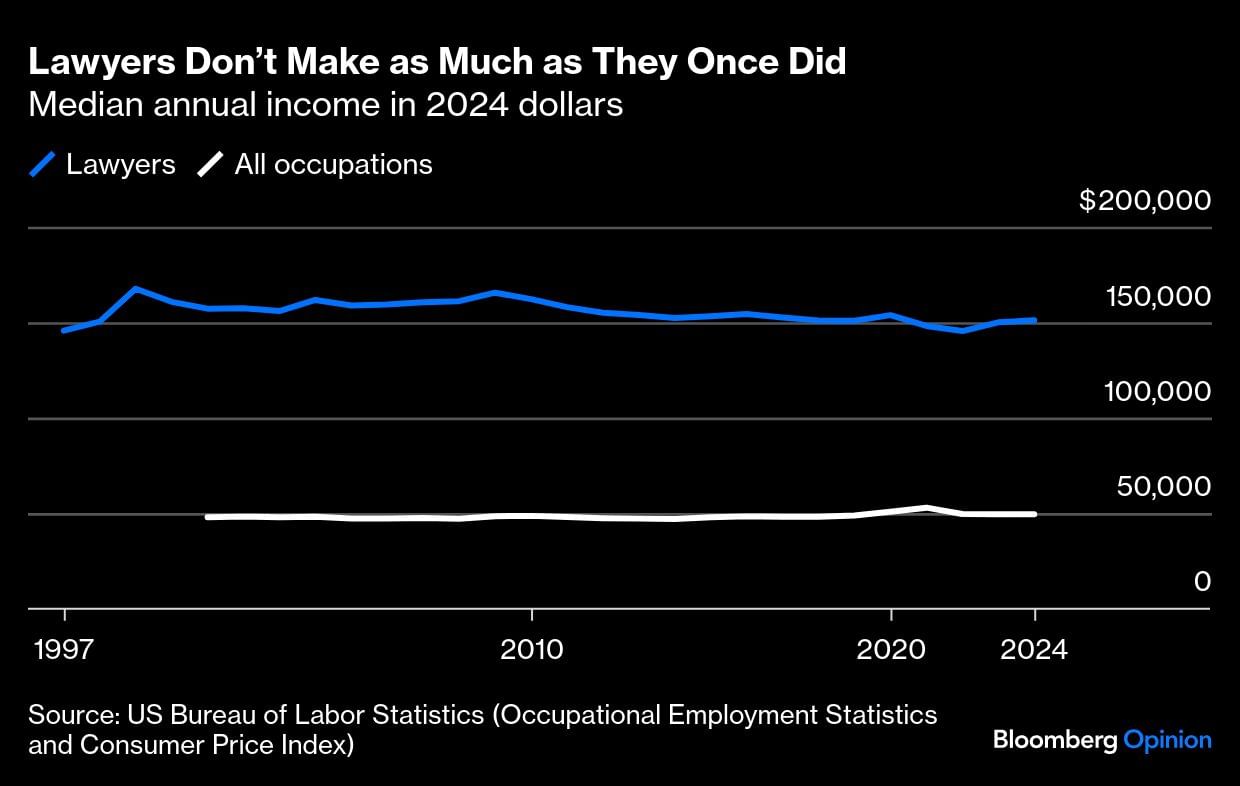
Lawyers’ share of the professional workforce has also declined. The monthly payroll employment numbers from the BLS — which are sorted by industry, not occupation — show that while employment in legal services has grown over the past three decades, the sector’s share of professional, scientific and technical services jobs has become much smaller.
The impression I get from these last three charts is that lawyering has become lower-status work than it was 50 or 25 years ago. That speaks in part to growing opportunities elsewhere in the economy, especially in tech-related work, which seems like a good thing. There’s a long-running academic debate about whether lawyers promote economic growth or impede it, with one of the most recent contributions arguing on the basis of data from the 50 states that it’s the latter.
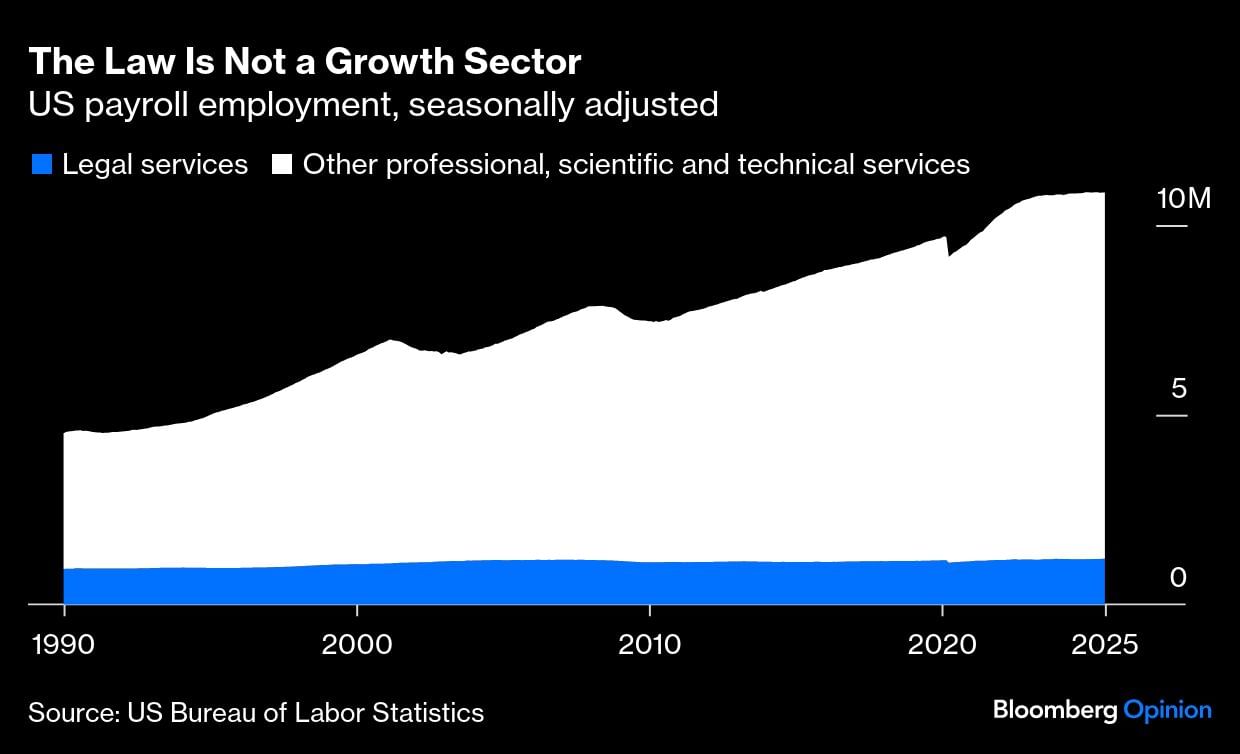
The US has, however, been a lawyer-heavy nation from the beginning. Of the 56 signers of the Declaration of Independence, 25 were lawyers. Of the 45 US presidents, 26 have been. The current occupant of the White House is not and has been uniquely dismissive of lawyers and the rule of law. A growing majority of Americans disapprove. So maybe the current law school boom is good news after all.
Justin Fox is a Bloomberg Opinion columnist covering business, economics and other topics involving charts. A former editorial director of the Harvard Business Review, he is author of “The Myth of the Rational Market.”
Disclaimer: This report is auto generated from the Bloomberg news service. ThePrint holds no responsibility for its content.



